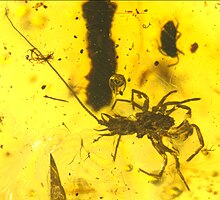| Chimerarachne Temporal range:
| |
|---|---|

| |
| C. yingi specimen NIGP167161 in amber | |

| |
| Life reconstruction of C. yingi | |
| Scientific classification | |
| Domain: | Eukaryota |
| Kingdom: | Animalia |
| Phylum: | Arthropoda |
| Subphylum: | Chelicerata |
| Class: | Arachnida |
| Clade: | Tetrapulmonata |
| Suborder: | †Chimerarachnida |
| Family: | †Chimerarachnidae |
| Genus: | †Chimerarachne Wang et al., 2018 |
| Type species | |
| †Chimerarachne yingi Wang et al., 2018
| |
| Species | |
| |
| Synonyms | |
|
Parachimerarachne Wunderlich, 2022 | |
Chimerarachne is a genus of extinct arachnids, containing five species.[1] Fossils of Chimerarachne were discovered in Burmese amber from Myanmar which dates to the mid-Cretaceous, about 100 million years ago. It is thought to be closely related to spiders, but outside any living spider clade.[2] The earliest spider fossils are from the Carboniferous, requiring at least a 170 myr ghost lineage with no fossil record. The size of the animal is quite small, being only 2.5 millimetres (0.098 in) in body length, with the tail being about 3 millimetres (0.12 in) in length. These fossils resemble spiders in having two of their key defining features: spinnerets for spinning silk, and a modified male organ on the pedipalp for transferring sperm. At the same time they retain a whip-like tail, rather like that of a whip scorpion and uraraneids. Chimerarachne is not ancestral to spiders, being much younger than the oldest spiders which are known from the Carboniferous, but it appears to be a late survivor of an extinct group which was probably very close to the origins of spiders. It suggests that there used to be spider-like animals with tails which lived alongside true spiders for at least 200 million years.
- ^ Wunderlich, J. (2023). "Contribution to the spider (Araneida: Araneae and Chimerarachnida) fauna in upper (mid) Cretaceous Burmese (kachin) amber". Beiträge zur Araneologie. 16: 162–215.
- ^ Wang, Bo; Dunlop, Jason A.; Selden, Paul A.; Garwood, Russell J.; Shear, William A.; Müller, Patrick; Lei, Xiaojie (2018). "Cretaceous arachnid Chimerarachne yingi gen. et sp. nov. illuminates spider origins". Nature Ecology & Evolution. 2 (4): 614–622. Bibcode:2018NatEE...2..614W. doi:10.1038/s41559-017-0449-3. ISSN 2397-334X. PMID 29403075. S2CID 4239867.